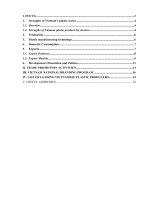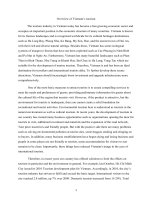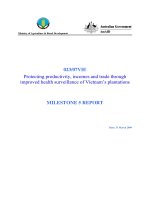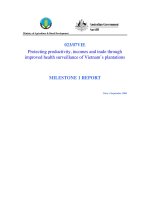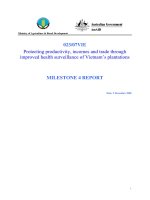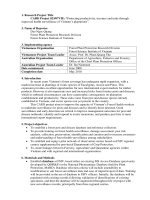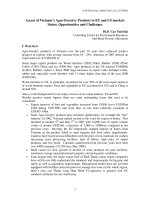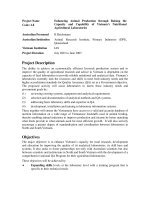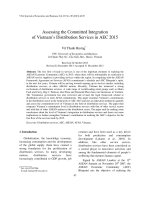Strengths of Vietnam’s plastic sector
Bạn đang xem bản rút gọn của tài liệu. Xem và tải ngay bản đầy đủ của tài liệu tại đây (446.13 KB, 22 trang )
I. FOCUS.......................................................................................................................................2
1.Strengths of Vietnam’s plastic sector......................................................................................3
1.1.Overview..................................................................................................................................3
1.2.Strengths of Vietnam plastic products by clusters.............................................................3
2.Production..................................................................................................................................4
3.Plastic manufacturing technology...........................................................................................5
4.Domestic Consumption.............................................................................................................5
5.Exports........................................................................................................................................6
5.1.Export Products......................................................................................................................7
5.2.Export Markets.......................................................................................................................8
6.Development Orientation and Policies..................................................................................10
II. TRADE PROMOTION ACTIVITIES...............................................................................12
III. VIETNAM NATIONAL BRANDING PROGRAM........................................................15
IV. LIST OF LEADING VIETNAMESE PLASTIC PRODUCERS..................................17
PLASTIC 04 CORPORATION................................................................................................19
V. USEFUL ADDRESSES.........................................................................................................20
I. FOCUS
Vietnam’s plastic industry includes about 2,000 businesses from North to South. Most (83%)
are in the South - Hochiminh city, Binh Duong, Dong Nai, Long An, and Ba Ria Vung Tau.
The North has 13% of them, and the Central 3%.
Plastic products having a great competitive edge are packaging, household products, and
construction and engineering plastics. Vietnamese plastic products are, in the main, exported.
These plastic products have gradually reached the point to where they control the market of
several countries.
In the domestic market, Vietnamese plastic products are present in most industries -
agriculture, transportation and communications, seafood and fishery, construction, electrics and
electronics sectors, etc. Products requiring high quality such as oil pipelines, plastics for car
and computer industries are being produced successfully in Vietnam.
In overseas markets, Vietnamese plastic products are known for their outstanding
competitiveness. After all, the industry’s manufacturing technology is right there with the best
in the world as for modern technology, thereby earning market acceptance. Vietnamese plastic
products are sold in over 150 countries, including Japan, Cambodia, Laos, Thailand, China,
India, Africa, EU, and USA.
Among export markets, Vietnam plastics have earned firm entrenchment in Japan, and add to
that new potential markets such as China, India, Russia, East Europe, and Africa with their
demand for plastic packaging, and household and construction materials.
Application Splits for Plastic Usage in Vietnam
Source: Vietnam Plastics Association
1. Strengths of Vietnam’s plastic sector
1.1. Overview
- The plastic manufacturing industry is one the fastest growing industries in Vietnam,
sustaining average annual growth of 20% to 25%.
- Employees have a solid educational background, are hardworking and capable of advancing
their skills.
- Plastic products were one of the fastest growing exports in Vietnam in the last five years and
have great potential to perform well on the international market.
- The plastics sector is aggressively promoted by the Vietnamese government. It aims to
achieve sufficient supply of home-produced raw material through resin production facilities. In
parallel, the government issued a blueprint for developing supporting industries such as mold-
making, plastic recycling, chemistry and machinery supply.
- Modern manufacturing equipment such as: calendering and coating, extrusion molding,
injection molding, extrusion blowing, laminating and printing lines... have basically met
plastics production for end-user consumption, construction, packaging, and engineering
sectors.
- Several businesses have built up their brand prestige in local market; examples are Binh Minh
JS Co., Tien Phong, Minh Hung plastic pipes; Plastic packaging of Tan Tien, Rang Dong, Van
Don JS Co., PET bottles and 3-layer bottles of Oai Hung, Ngoc Nghia, and Tan Phu Plastic Co.
...
- Some businesses have constant overseas orders of quite great quantity; examples are Rang
Dong Plastic JS Co. with their tablecloths and synthetic leather products, Tan Dai Hung Plastic
JS Co. with PP woven bags, and Hung Yen Plastic JS Co. with HDPE shopping bags and
garbage bags.
1.2. Strengths of Vietnam plastic products by clusters
a) PE films and bags
- Printing capability: Some Vietnamese manufacturers demonstrate their ability to care for a
nice printed bag that could constitute a plus for the Vietnamese manufacturers when compared
with Chinese manufacturers, as well as an ability to remain flexible and deal with smaller
orders.
- Fast development of internal demand will also support export; for instance the plastic
packaging supply to the growing domestic export businesses in food, electronic equipment and
garments will make the critical mass for production achieved faster.
- Some established contacts with international-buying decision-makers exist already and may
be consolidated. Further, Vietnam’s image in developed nations seems good and may be
further capitalized.
- The ability to reduce film thickness through optimum choice of resin is not obvious. The resin
available in Vietnam is considered adequate.
b) Woven webbing and bags
- This segment includes the following products:
Consumer (essentially heavy-duty multi-trip Reusable shopping bags)
Industrial 25 kg bags
Leno & Rachel bags
FIBC (flexible intermediate bulk containers)
Agricultural, Construction & Tarpaulin
- State-of-the-art manufacturing capabilities of the Vietnamese operators are presented in this
segment; LOHIA STARLINGER lines, at tape extrusion and stretching level as well as
weaving level, which offer good overall competitive performance against best competitors.
Relative homogeneity of origin of machines makes monitoring of performance and
maintenance easier within the country.
- Combination of cheap and skilled employees for product confection and assembly using
textile-based sewing technology is a plus.
- ISO certification is now in place and running. Implementation of quality control for the
webbing products is a prerequisite for establishing recognition of quality supplier.
c) Laminations
- Development of the domestic food market and of modern distribution and retail will push for
more portion packaging, reinforcing the segment.
- Manufacturers seem quite dedicated to quality improvement and diversification. Multilayer
equipment is in place. Overall quality of print laminates is an asset for supply of demanding
export markets such as Japan and Europe.
d) Sheets extrusion & formed containers
- There is one competent and dedicated operator who invested in a co-extrusion state-of-the-art
line.
e) Injection molding products
- Low cost resulting from low labor cost essentially and dependability for some relatively
simple injection molded parts such as those close to consumer goods.
- One operator has the advantage of performing with a large clamping force machine allowing
injection molding of large parts such as pallets.
f) HDPE blow molding products
- Ability to network with local companies involved in the supply of labels and shrink sleeves
for quality print on small blow molded containers.
g) Flexible packaging tubes
- The cluster has a complete range of products, which covers all packers’ needs and has
certification credentials.
- One world-class operator procured a co-extrusion state-of-the-art line, and 8 color printing
capability.
- The cluster seems to manage well its promotional tools, including facilitation of information
supply for export such as quantity per type of product and per 20’ container loads.
- The cluster has a track record of multiplicity of clients that implies an ability to also serve
modest-sized markets and orders.
2. Production
Vietnam’s plastic output grew steadily and strongly at an average of 15% a year over the past
decade. Despite the global economic downturn and sharp price fluctuations of plastic materials
in 2008, plastic output reached 2.3 million tons, up by 22 percent against 2007. The country’s
plastic industry is expected to continue this upward trend for many years to come.
Figure 1: Vietnam’s plastic output in 2000-2010 (in thousand tons)
Source: Vietnam Plastics Association
Of the total annual plastic output, plastic packaging accounts for 36% while plastic
construction materials, house-ware and components for other industries such as electronics,
electrical and transportation account for 16%, 36% and 12% respectively.
3. Plastic manufacturing technology
The technology Vietnam uses to produce its broad array of plastic products includes:
Injection technology: This technology is used to make plastic components and parts for the
electronics, electrical power, motorbike and automobile industries. According to industry
experts, there are approximately 3,000 pieces of injection equipment in Vietnam.
Blow-Extrusion technology: This is a pellicle-blowing technology to make plastic packaging
materials from pellicles. This technology is used for blowing polyethylene (PE), polypropylene
(PP) bags and PVC pellicles. A large number of plastic product manufacturers in Vietnam are
using blow-extrusion machines to produce plastic packaging products, including PET bottles
and kegs.
Profile technology: In Vietnam, this technology is used for making such products as water
drainage PVC pipes, water supply PE pipes, aluminum-plastic pipes, optic cables, PVC doors,
frames, roofing, and wall coverings.
Generally speaking, advanced plastic manufacturing technology is used in Vietnam, although
not as widely as it could be. Since 2005, many plastic manufacturers in Vietnam have invested
considerable money in upgrading their manufacturing equipment and machinery to improve
their products in terms of quality and design, thus being able to compete successfully in
domestic and international markets. For instance, a few large firms are manufacturing high-
quality and hi-tech plastic products by using advanced equipment and machines imported from
Germany, Italy and Japan. This trend will continue as the Vietnamese plastics industry strives
to maintain competitiveness and extend reach in world markets.
4. Domestic Consumption
Vietnam’s plastic manufacturing industry has sustained particularly high growth thanks to the
significant increase in both domestic consumption and exports since 2000. Plastic consumption
per capita in Vietnam was only 1 kg/year in 1975 and remained static until 1990. Consumption
per capita grew steadily until 2000 when each person living in Vietnam, on average, consumed
12 kg/year, and this trend continued; in 2008, for example, the figure was 34 kg/person.
The government of Vietnam expects consumption per capita to reach 40 kg/year in 2010. This
dramatic increase in plastic consumption per capita is, for the most part, attributed to a soaring
foreign direct investment inflow; the robust growth of Vietnam’s manufacturing, construction
and transportation sectors; and the growing per capita income of the Vietnamese people, in the
wake of the implementation of the “Economic Renovation” policy beginning in 1986.
Figure 2: Vietnam’s plastic consumption per capita growth (in kg/person)
Source: Vietnam Ministry of Industry and Trade
5. Exports
2010 was a brilliantly successful year for Vietnam plastic exports, with export revenue for this
product surpassing 1 billion USD for the first time. According to the General Customs Bureau
official records for 2010, total export revenue of Vietnam plastic products was 1,049,000,000
USD, surpassing 2009’s by 30%. Total export revenue exceeded 2010’s target by 5%. This is
considerable growth by Vietnam plastic industry, showing a strong recovery of the industry
after the 2008 financial crisis, a positive sign of a bold development seen in Vietnam plastic
industry and giving a signal for a fully successful year for 2011.
Vietnam’s export revenue for plastics grows constantly. Contrast that 1+ billion of the present
with 2005’s export revenue of a mere 336 million USD. Vietnam plastics are exported to, for
example, Japan, USA, The Netherlands, Germany, Cambodia, UK, Indonesia, and Malaysia,
and have been shipped to 151 countries.
Figure 3: Vietnam plastic export revenue in 2004-2010 (in million USD)
Source: National Statistics/Vietnam Plastics Association
5.1. Export Products
At this moment Vietnam exports over 20 categories of plastic products to world markets, of
which three categories had export revenue of over 100 million USD and 8 categories of over
10 million USD in the year 2010. Export revenue of main products such as plastic sheets,
boards and films, household and industrial plastic products, tarpaulin, statues, flower pots, and
ornamentals are rising stronger than in recent years.
Spilt of Plastics Products for Export 2010
Source: National Statistics/Vietnam Plastics Association
Product categories having highest export revenue in the year 2010 were products used in
transportation, packaging which are also Vietnam’s core export products. Year 2010 total
export revenue of these categories totaled 387 million USD, a year-on-year increase of 12%.
These products are accounting for highest export value equivalent to 37% of general export
revenue of 2010. Main import markets of these products in 2010 included Japan, Germany,
UK, USA, and Cambodia.
2009-2010 Export Plastic Products Categories
Category 2009
(USD)
2010
(USD)
2010/2009
(%)
Products used in forwarding and packaging 345,360,475 387,141,656 12.1
Plastic sheets, boards, films 113,871,115 202,396,812 77.7
Household plastic products 57,889,541 109,640,193 89.4
Industrial plastic products 66,864,703 84,904,947 27
Tarpaulin 43,457,321 65,167,407 50
Small statues, flower pots, and ornamentals 36,858,418 48,839,807 32.5
Offices, school equipment 32,824,185 37,236,234 13.8
Pipes and fittings 15,180,029 31,391,345 40.9
Materials used in construction 10,119,348 14,556,676 43.9
Sanitary equipment 10,271,424 13,395,137 30.4
Cosmetics cases 11,025,114 9,180,678 -16.7
Caps, lids, valve caps 8,203,561 7,211,813 -12.1
Belts 5,021,203 6,407,614 27.6
Home, automobile fittings 7,272,712 4,754,071 -34.6
Safety and safeguarding equipment, tools 4,991,762 3,208,955 -35.7
Sanitary, medical and surgical products 1,853,111 2,567,475 38.5
Toys 4,501,657 995,919 -77.9
Thread bobbins, reels 632,345 857,801 35.7
Garment and accessories 3,998,800 675,517 -83.1
Others 20,778,188 16,697,076 -19.6
Source: Vietnam Plastics Association
5.2. Export Markets
In 2010, Vietnam plastics were exported to 151 world markets, of which exports to Japan hit
figures far higher than others with its 259 million USD. In addition, 20 other markets reached
over 10 million USD and 38 others exceeded 1 million USD in the recent year of 2010.
10 main export markets of Vietnam plastic products in 2010
Source: Vietnam General Statistics Office
